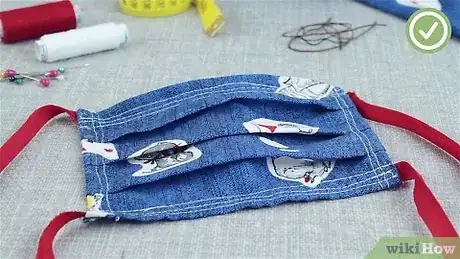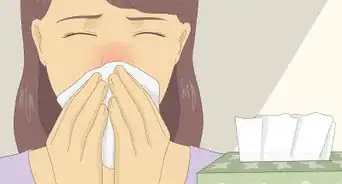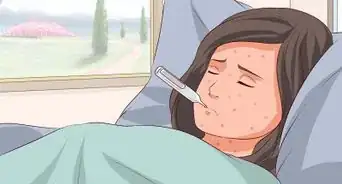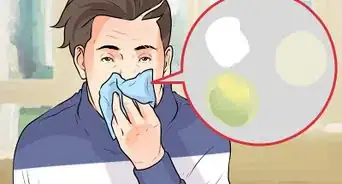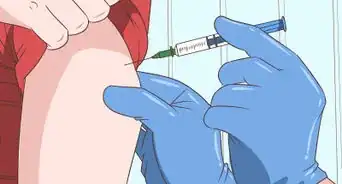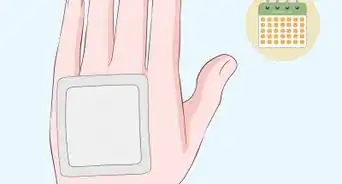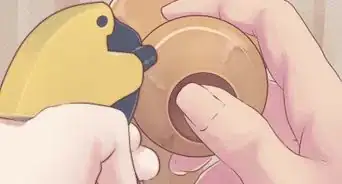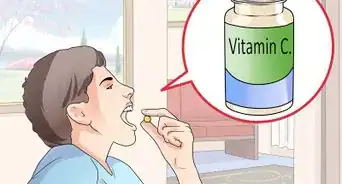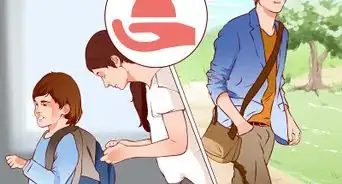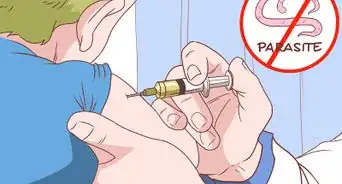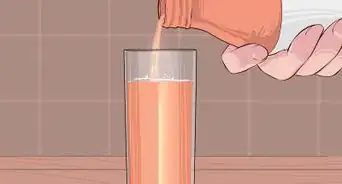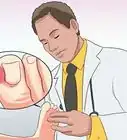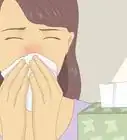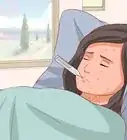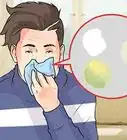This article was co-authored by Megan Connolly and by wikiHow staff writer, Danielle Blinka, MA, MPA. Megan Connolly is a Sewing Specialist with over 40 years of sewing experience. She specializes in creating crafts and clothing garments such as face masks, scarves, and dresses. Using over 18 years of experience in software technology, Megan has served as the Director of Technology and Advisor to Robotics Teams at The Haverford School in Haverford, Pennsylvania. She has a BS in Mathematics from Temple University.
There are 7 references cited in this article, which can be found at the bottom of the page.
This article has been viewed 100,335 times.
You might want to wear a fabric medical mask to help prevent the spread of COVID-19. Additionally, sewing and donating fabric masks is a great way to help healthcare providers who are on the front lines of the pandemic. Although fabric masks aren’t as effective as medical-grade masks, they may provide some protection against germs.[1]
Fortunately, these masks are very simple to make, even if you're just learning to sew. If you have a bit more sewing experience, you can create a medical mask with a more complex design.
Warning: Cloth masks are ineffective in preventing the spread of more infectious variants of COVID-19, like Delta and Omicron. Medical-grade masks are necessary to limit the spread and risk of infection from the current dominant variants of the coronavirus.[2]
Steps
Simple Mask Template
Cutting Your Fabric
-
1Clean your hands and work area before making a mask. When you’re making a medical mask, it’s important to use good hygiene. Wash your hands with soap and water for at least 20 seconds to make sure they’re clean. Additionally, use bleach wipes or a bleach spray to disinfect your tools and work surface.[3]
- If you’re making masks to donate to health care providers, consider wearing a face mask while you make them. This way you won’t accidentally breathe, cough, or sneeze on the masks you’re making.
-
2Pick a heavy-weight, tight-woven fabric, such as cotton. A tight weave will provide better protection from germs. Use a cute decorative fabric if you have it. However, you can also use a heavy-weight T-shirt or pillowcase if that’s all you have.[4]
- You may be able to get free supplies from a local fabric or craft store if you’re donating the masks. For instance, Joann Fabrics will provide the materials you need to make masks for donations, free of charge.[5]
Advertisement -
3Print and cut out the CDC-approved pattern. Check that the pattern will print at the actual size, then print it out and double-check the scale to make sure it’s right. Use your scissors to cut out the fabric.
- If you don’t have a printer, just cut out a rectangle that’s 7 in (18 cm) wide x 8 in (20 cm) tall. Then, reference the pattern as a guide while you’re working. This mask is pretty easy to make.
-
4Trace the pattern onto your fabric and cut it out. Lay the fabric on your work surface with the “good” side facing down. Place the pattern on the fabric, then use a pencil or fabric chalk to trace around it. Finally, use fabric scissors (or sharp scissors) to cut out the rectangle.
- Keep the pattern nearby because it’ll help you figure out where to fold the fabric when you’re making the body of the mask.
-
5Cut two 36 in × 0.5 in (91.4 cm × 1.3 cm) strips of fabric to use for ties. Using fabric ties makes it easier to construct your mask, as you need fewer materials. Additionally, you can easily adjust the fit of your mask by tightening or loosening the ties. Use fabric scissors to cut your ties.
- If you have fabric with different patterns or colors, you might want to use a different fabric for your straps.
Variation: You can use elastic instead of fabric strips if you prefer. For best results, use elastic that's 1⁄4 in (0.64 cm) or 3⁄8 in (0.95 cm) wide. Cut two 7 in (18 cm) strips of elastic for each mask.[6]
Making the Mask
-
1Fold the top 0.5 in (1.3 cm) edge of the backside over a fabric tie. Place the fabric you're using for the mask body on your workspace with the "good" side down. Lay the first fabric tie down on the top of the rectangle. Make sure the fabric strip is centered so that there’s an equal length on either side of the mask. Then, fold the top edge of the backside of the mask over the fabric strip.
- To make sure your straps stay in place, line up the rough edge of the fabric with the bottom of the fabric strip.
-
2Sew along the top to secure the fabric strip. Use your sewing machine or a needle and thread to do straight stitches along the rough edge of the fabric. Go all the way across from 1 end of the fabric to the other. Leave the sides open so you can insert a wire.
- This stitch will hold the fabric tie in place and leave a small tunnel at the top of the mask.
Variation: If you’re using elastic, fold the top of the backside of the fabric down and sew a "tunnel" across the top of the mask. Then, insert metal floral wire or a stripped twisty tie into the middle of the tunnel. Next, use straight stitches to attach 1 end of an elastic piece at the edge of the tunnel you made. Finally, sew straight stitches to attach 1 end of the other elastic piece on the other side of the tunnel.[7]
-
3Insert metal floral wire into the pocket at the top of the mask. Cut about 5.5 in (14 cm) of floral wire. Slide the metal wire into the tunnel you just created when you stitched down the top strap. Use your fingers to push the wire into place at the top of the mask. This wire will allow the wearer to adjust the mask around their nose.
- If you don’t have any metal wire, use a twisty tie. Just strip off the paper first, as it will come off in the wash if you don’t.
-
4Make 3 small folds over the center of the mask to create pleats. The pleating helps the mask contour to the wearer's face. Make the first fold about 0.5 in (1.3 cm) below the top of your mask. Then, make another 0.5 in (1.3 cm) fold and pin the pleat in place. Repeat the process once more to create a total of 3 pleats. Leave about 1 in (2.5 cm) of fabric at the bottom so you can attach the other strap.
- Use the mask pattern as a guide for making your pleats.
-
5Stitch up the sides of the mask to secure the pleats and wire. Once you’ve folded all of the pleats, fold the edges of the front side of the fabric about 0.25 in (0.64 cm) over to the back. Then, sew straight stitches up each side to create side seams. Not only will this secure your pleats, but it’ll also prevent the nose wire from falling out.
- Don’t forget to use the pattern for reference.
-
6Fold the bottom 0.5 in (1.3 cm) over the second fabric strip. Lay the second fabric strip over the bottom of the mask. Make sure the strip is centered so that there will be equal amounts of strap on either side of the mask. Then, fold the lower edge of the backside of the mask over the fabric strip. Line up the rough edge of the fabric with the top edge of the strip. Then, sew straight stitches along the rough edge to secure the mask around the bottom strap.
- This is exactly like the first step for making the mask.
Variation: If you’re using elastic instead of fabric strips, fold the bottom 0.5 in (1.3 cm) of the backside of the mask up and sew along the rough edge using a straight stitch to make another tunnel. Starting on the right side, insert the free end of the elastic you attached at the top of the mask into the tunnel and use straight stitches to sew it in place. Then, repeat on the left side. This will create 2 ear loops on either side of the mask.[8]
-
7Sew a topstitch around the perimeter of the mask twice to secure it. Use your sewing machine or a hand sewing needle and thread to complete the topstitch. This will reduce the risk of your mask fraying or coming apart.[9]
- You can skip the topstitch if you’re in a hurry. However, your mask will hold up better in the wash if you add a topstitch.
-
8Wash your mask before wearing it. Your mask won’t be able to protect you from germs if it’s dirty. To sanitize it, wash it in detergent on a hot setting. Then, dry it in your dryer for best results.[10]
- If necessary, you can air-dry your mask. However, heat will kill more germs, so using a dryer is your best bet.
- If you don't have a washing machine, sanitize the mask by boiling it for 10 minutes. Then, lay it out on a sanitized surface to air dry.[11]
Things You'll Need
- Fabric
- Floral wire or twisty tie
- Elastic (optional)
- Pattern
- Pencil or fabric chalk
- Sewing machine or hand sewing needle
- Thread
- Fabric scissors (or sharp scissors)
- Fabric pins
Warnings
- Homemade medical masks aren’t as effective as medical-grade masks, which can block up to 95% of germs. Only use a homemade fabric mask if you don’t have access to a medical-grade mask.[13]⧼thumbs_response⧽
References
- ↑ https://wwwnc.cdc.gov/eid/article/12/6/05-1468_article
- ↑ https://health.clevelandclinic.org/are-cloth-masks-enough-against-omicron/
- ↑ https://www.youtube.com/watch?v=M19HtUhBcM8&feature=youtu.be&t=18
- ↑ https://wwwnc.cdc.gov/eid/article/12/6/05-1468_article
- ↑ https://www.joann.com/make-to-give-response/
- ↑ https://www.allinahealth.org/-/media/allina-health/files/mask-sewing-how-to.pdf
- ↑ https://www.allinahealth.org/-/media/allina-health/files/mask-sewing-how-to.pdf
- ↑ https://www.allinahealth.org/-/media/allina-health/files/mask-sewing-how-to.pdf
- ↑ https://www.allinahealth.org/-/media/allina-health/files/mask-sewing-how-to.pdf
About This Article
To sew your own medical mask, start with heavyweight, tight-woven fabric, like a pre-shrunk cotton t-shirt. Cut out one 7 by 8-inch (18 by 20-cm) rectangle and two 36 by ½-inch (91 by 1-cm) strips. Then, center one of the strips at the top of the rectangle, and fold the top edge of the rectangle down ½ inch (1 cm) over the strip. Sew along the raw edge to create a pocket. Next, take a metal wire for the nose piece and bend it in half and flatten it. Insert the metal wire into the pocket so it’s centered, then stitch the pocket closed to secure it in place. Now, make 3 evenly-spaced pleats going down from the top of the mask. Sew down the sides of the mask to secure the pleats. Then, center the second strip at the bottom of the rectangle, and fold the bottom edge of the rectangle up ½ inch (1 cm) over the strip. Finally, sew along the raw edge and catch the strip in the seam to secure it. To use your mask, place the fabric over your nose and mouth and mold the metal wire so it’s shaped to the bridge of your nose. Then, tie the ends of the strips together behind your head. A homemade medical mask may help reduce your exposure to viruses and prevent you from spreading them if it’s all you have available, but keep in mind that it won’t be as effective as a manufactured medical mask.



